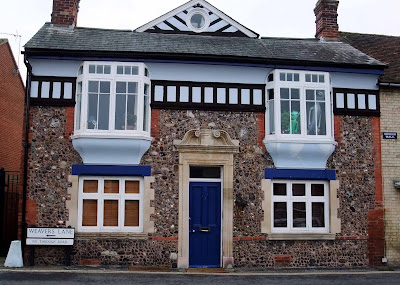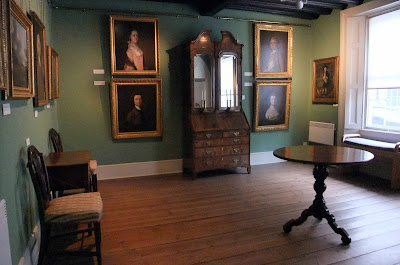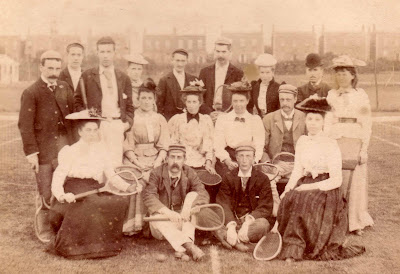Fortunately, we were able to get away to my mother-in-law's house for a few days and I took the opportunity to pay a visit to the wonderful Gainsborough Museum in Sudbury, Suffolk.
Sudbury is one of those pleasant market towns that, like Lewes, got left behind by the Industrial Revolution and went from being one of the most populous settlements to a relative backwater. Most of the buildings are pre-20th century and every street has a variety of quirky, eye-catching features:

 This house is unusual enough, even without the figures in the top-right window:
This house is unusual enough, even without the figures in the top-right window: I also liked the local church, St Gregory's, which is definitely worth a visit if you're in the area (if you aren't, this excellent website is a pretty good substitute).
I also liked the local church, St Gregory's, which is definitely worth a visit if you're in the area (if you aren't, this excellent website is a pretty good substitute).But I don't just enjoy snooping around empty churches for their historical interest. I also enjoy the glimpse they give into the secret life of middle England:
 There is something comforting about the parish noticeboard, with its posters advertising flower festivals, slide shows and amateur dramatics, run by people with names like Pam, Sheila and Malcolm. I may not want to see Brian's slide show about the Dutch tulip fields, but I feel strangely reassured by its existence.
There is something comforting about the parish noticeboard, with its posters advertising flower festivals, slide shows and amateur dramatics, run by people with names like Pam, Sheila and Malcolm. I may not want to see Brian's slide show about the Dutch tulip fields, but I feel strangely reassured by its existence.The house where Gainsborough was born is tucked away in a quiet back street and looked disconcertingly small. Fortunately, it is deceptively spacious, with a number of rooms like this one:
 Gainsborough's home became a museum in 1961 and over the last 50 years, the collection has steadily grown. I noticed that several paintings had been donated "in lieu of inheritance tax".
Gainsborough's home became a museum in 1961 and over the last 50 years, the collection has steadily grown. I noticed that several paintings had been donated "in lieu of inheritance tax".I used to regard Gainsborough as a bit of a lightweight, but a wonderful Tate exhibition in 2002 completely changed my mind and I've wanted to visit this museum ever since. As small museums go, this is one of the better ones, but I was hoping to see more of the well-known paintings, like Mr and Mrs Andrews.
Apart from the traffic the hurtling through the town centre, I liked Sudbury. It had managed to avoid the worst aspects of postwar town planning and still had a very distinct character, unlike most of Colchester, which I visited a day earlier:
 Colchester is the oldest recorded town in Britain and some of the original Roman walls - nearly 2,000 years old - still remain around the fringes of the centre. You would imagine that they would occupy pride of place in the town, but intstead the local authorities have sandwiched them between a busy ring road and some bland, 1980s buildings. It's shameful.
Colchester is the oldest recorded town in Britain and some of the original Roman walls - nearly 2,000 years old - still remain around the fringes of the centre. You would imagine that they would occupy pride of place in the town, but intstead the local authorities have sandwiched them between a busy ring road and some bland, 1980s buildings. It's shameful.On a more positive note, I found some superb things at work:
 These illustrations are from an early 20s German children's novel called 'Frau Major's Daughters'. I was very surprised to find that the book wasn't even worth a fiver.
These illustrations are from an early 20s German children's novel called 'Frau Major's Daughters'. I was very surprised to find that the book wasn't even worth a fiver. I wish I could look at illustrations like this without thinking of some dark, kinky subtext. Oh, to be innocent again!
I wish I could look at illustrations like this without thinking of some dark, kinky subtext. Oh, to be innocent again!I also liked the cover of 'The Crimson Rust' (also worth less than £5), which I'm sure Pam, Sheila and Malcolm would have enjoyed when they were children:
 Finally, two photographs:
Finally, two photographs: I quite like this group photograph of some Victorian tennis players, but my favourite by far has to be this:
I quite like this group photograph of some Victorian tennis players, but my favourite by far has to be this: Unusually, this photo actually has some information written on the back:
Unusually, this photo actually has some information written on the back:"Chief Civil Engineer's Office, KINGS CROSS (Great Northern Railway), Christmas Eve 1954"
I presume that the Chief Engineer is the very serious-looking man at the front, rather than the cad with the moustache or the 13-year-old boy at the back.
I apologise for the rambling, fragmented nature of this post. It has been that sort of week.







































